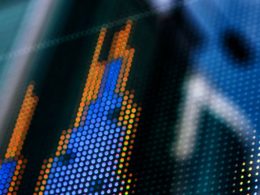by Jurrien Timmer, Director of Global Macro, Fidelity Investments
Key takeaways
- With trade tensions intensifying at the same time the US economy has joined the rest of the world in a slowdown, the onus is now on the Federal Reserve to save the day.
- A lower price-to-earnings ratio is the price of policy uncertainty, with the post-referendum Brexit experience in the UK providing a possible roadmap for the United States.
- Investors seem to be solving for cash flow rather than P/E, which, if it continues, could extend the current odd-couple leadership of growth stocks and bond proxies.
- Only a bad recession is likely to derail the current free cash flow engine, especially given peak margins
Ten years into an epic bull run for the US stock market and economy, investors have lately been experiencing increasing uncertainty. Trade tensions between the US and China seem to be going from bad to worse, while at the same time the US economy has apparently joined the rest of the world in slowing down. While the US and global economies remain in expansion mode, the Institute for Supply Management (ISM) manufacturing index has fallen from a cyclical high of about 61 last August to 52 as of May 2019, indicating the US has joined most other regions in a slowdown that, for them, started much earlier. The most recent employment report showed a clear deceleration as well.
As a result, the market has been clamoring for the US Federal Reserve to cut rates—and soon. Until recently, it was enough for the markets that the Fed had pivoted from signaling more rate hikes to no more hikes, but now the market has upped the ante from no rate hike to several rate cuts. The Fed has been resisting these signals for a while, but Fed officials seemed to indicate that indeed a rate cut might be coming soon. As of this writing, the market is placing high odds of a July cut and near-perfect odds of a September cut.
In stark contrast to an S&P 500® index trading near its all-time highs, the US bond market is now more or less priced for recession, with the 10-year Treasury yield recently falling to a mere 2.05%, and the yield on 2-year notes falling to 1.76%. Against a federal funds target range of 2.25% to 2.50%, that's an inverted yield curve, which as we all know has been a reliable leading indicator of recessions in the past. Indeed, the one question I can always count on these days is: "When is the next recession?" For many, it's not a question of if, but when.
But I still have my doubts as to the signaling power of today's inverted curve, given that the Fed's policy rate is barely at the so-called natural rate—the notional rate of interest that keeps the economy growing, employment high, and inflation stable. In the past, the fed funds rate would need to be 2 to 3 percentage points above the natural rate to signal a recession. Nevertheless, given its long and reliable history, the yield curve's message certainly should not be dismissed.
To me, the yield curve is the market's way of putting the Federal Reserve on notice that it is too restrictive. If the Fed ignores this message for too long, a recession may well ensue. But if the Fed responds quickly with several rate cuts (much like it did in 1995 and late 1998), then a recession can potentially be averted. In fact, despite the big decline in yields—from 3.23% last September to 2.05% more recently—the yield curve seems to support the notion of rate-cut salvation, given that the slope is positive from 3 years out. In other words, the bond market seems to be assuming that the Fed will deliver multiple rate cuts in the coming 2 years and that these cuts will lead to an economic soft landing. I think that's about right, but until the Fed actually delivers the rate cuts and, in the process, "un-inverts" the yield curve, we are left hoping for the best and fearing the worst.
State of flux
I am a big believer in the discounted cash flow (DCF) model, and right now both the numerator (earnings growth) and the denominator (the cost of capital) are in a state of flux. What's left in the lurch is valuation and therefore price (since mathematically the total return is equal to earnings growth plus dividends plus changes in the P/E ratio). When both sides of the DCF are up in the air, the market is left with a choppy price-discovery process, and that often means volatility and lower P/E multiples. For me, that about sums things up these days.
If the drawn-out Brexit saga has taught us anything, it's that the price of a prolonged period of uncertainty is a lower P/E multiple. Since the Brexit referendum in June 2016, the stock market and economy in the UK have done OK; earnings are up a solid 30%, but the forward P/E ratio on the MSCI United Kingdom Index has fallen from 16x to 12x. For the US stock market, the forward P/E multiple peaked at 19.5x in January of 2018, right around the time that trade tensions with China started to develop. By last December, the forward P/E had fallen to 13.7x and subsequently recovered to 17.1x. As of the end of May, it stood at 16.5x, which is on the high side of normal but not at what I consider "nosebleed" levels. So, as I see it, if trade tensions continue to rise, it's quite plausible that valuation multiples in the US could compress further. The question is: How much?
I doubt that US multiples will fall as much as they did in the UK, given that with a shareholder-friendly focus on free cash flow (FCF) and share buybacks, US company fundamentals generally are more favorable. But these fundamentals certainly could deteriorate if things really drag on in terms of trade. This is especially true given that US companies have been the beneficiary of high profit margins, which last year reached 12%. I have no doubt those margins have been boosted by a combination of tax cuts and deregulation, but I also have little doubt that globalization has been a big part of the story as well. And if a US–China trade war signals the peak of the era of globalization, then perhaps it marks a peak for profit margins too.
We can talk about who might be the winners and losers in a trade war, but so far China clearly has taken the brunt of the hits. As of May, the Shanghai Composite Index was down 18% from its January 2018 peak, and the yuan is teetering precariously close to the 7.0 yuan/dollar threshold.
But I think, in all likelihood, all sides would lose to some degree if tensions were to escalate further. If we view tariffs as a tax, then the question is whether that tax gets passed on to consumers or eats into company profit margins. If it’s the consumer, maybe the real economy will keep doing OK given the backdrop of low unemployment, robust wage growth, and low levels of household debt. But if companies are unable to pass these tariffs on to their customers, then it could erode profit margins at a time when the stock market has become highly attuned to globalization, valuations are on the high side of normal, and US earnings growth has already slowed from 2018's 22% rate to something closer to 5% so far in 2019.
All about the cash flow
Some may argue with my assertion that valuations are only at high-neutral and not nosebleed levels and that therefore they have much further to fall. This is an age-old debate that is not likely to go away soon, since valuation is very much in the eye of the beholder.
For example, proponents of the Shiller CAPE (10-year cyclically adjusted P/E ratio) would argue that the market is extremely expensive at 27x (see chart: Different P/E lenses). Indeed, as of the end of May, the Shiller CAPE is at the 92nd percentile of the past 100+ years' worth of history—nosebleed indeed. Only during the bubble days of 1929 and 1999–2000 has the market been more expensive.
One problem with the Shiller CAPE, in my view, is that it includes the near-depression-level earnings from 2009. It took most of 2009 for earnings to recover from the global financial crisis. Once those weak, 10-year-old numbers roll off in the coming quarters, the CAPE should start to look a lot better. If for the sake of argument we assume no price gains from here amid consensus-like growth in earnings per share, the Shiller CAPE could fall to 22x over the next 2 years, placing it closer to the 75th percentile of historical valuation. That's by definition still above average, but against the backdrop of stable earnings and low inflation it doesn't seem too out of place.
For me, arguing about the proper P/E measure misses a broader point, which is that in today's world of aging demographics and low interest rates, investors seem to be concerned more with yield and cash flow and less with what price they have to pay for each dollar of earnings.
Many things about this market don't make sense to me from a traditional valuation perspective (see chart below). How can "boring" sectors like consumer staples and utilities challenge the P/E multiples of the general market—and even the mighty tech sector? At the end of May, their forward P/E ratios were 17.9x (consumer staples), 17.7x (utilities), 14.9x (S&P 500)®, and 17.0x (technology). Per the DCF, investors usually pay up for sustained strong earnings growth. That's indeed the case for tech and consumer discretionary stocks, but it's not what the more bond-like sectors offer. It doesn't make much sense until you view the market through the lens of cash flow.
Yield and cash flows seem to be what today's aging investors are solving for, especially given that most Treasury yields are at or below 2% and close to $11 trillion worth of global bonds are trading at negative yields. Boring "bond proxy" stocks may seem expensive by traditional measures, but less so when they are seen as yield vehicles. For instance, the S&P 500 Low Volatility High Dividend (LVHD) index delivers a dividend yield of 4.86%, more than twice as much as the broader market and more than 200 basis points higher than the Bloomberg Barclays US Aggregate Bond Index. Of course, these stocks come with equity levels of risk, but my sense is that perhaps investors are valuing these stocks against bonds instead of against the stock market—and equities seem cheap compared with bonds no matter how you look at it.
A similar contextual framework can be applied to the big secular growth stocks that have dominated the market landscape in recent years. Those companies pay either no dividends or low dividends; instead, they buy back a lot of shares with all the free cash flow they generate. If we add the buyback yield (total buybacks divided by total market capitalization) to the dividend yield, we get a total cash yield of more than 5% for the S&P 500. All of a sudden, through the lens of yield, the market's valuation starts to make sense, especially in contrast to those capital-intensive and highly cyclical sectors that tend to be found on the value side of the spectrum. When looking at its valuation through the lens of total cash yield instead of price-to-earnings, all of a sudden the S&P 500 sits at only the 28th percentile of historical valuation versus the Shiller CAPE's 92nd percentile.
This focus on shareholder value is unique to the United States: Companies in many other countries tend to be managed more toward the benefit of their employees. We can argue the merits of that, but the fact is that the focus on FCF and the resulting cash yield is an important factor in separating the US from the rest of the world in terms of market performance, much like growth stocks have done relative to value stocks. They are different sides of the same divide.
We can debate whether traditional valuation metrics still matter or whether "things really are different this time." I certainly never want to be the one who says that, but my point is that for now it doesn't seem to matter. Regardless of the merits, if investors are solving for cash flow above all else, then all of sudden many of the things about this market move from the illogical toward the logical.
The next question is: What can derail the current market leadership? We know that the demographic tide that has been unfolding around the world will continue for years to come, and presumably the need for yield will persist as a result. That suggests to me that the focus on cash flow will continue and with it the current market leadership. What about a recession?
I believe a recession could well disrupt the FCF machine that is behind both the growth/value and US/non-US equity divide. If a trade war takes an already slowing economy over the edge into earnings-led recession—at a time when margins also are peaking—then the FCF could dry up, taking the share buybacks with it. Perhaps this is why everyone seems so focused on the recession question: The stakes are very high indeed.
As for the "bond proxies," a recession would presumably only make them more popular given their low volatility and relatively high yields. In that sense, having both very "growthy" and more bond-like stocks in the same portfolio makes a certain amount of sense.
*****

Jurrien Timmer is the director of global macro in Fidelity's Global Asset Allocation Division, specializing in global macro strategy and active asset allocation. He joined Fidelity in 1995 as a technical research analyst.
Copyright © Fidelity Investments















